
Trump’s unprecedented move to designate Antifa as a domestic terrorist organization has thrust Oregon into a constitutional and cultural collision—one that could redefine the boundaries of federal power, protest, and the meaning of political violence in America.
Story Snapshot
- President Trump formally labels Antifa a domestic terrorist group, targeting its activity in Oregon.
- Federal and local authorities face new pressures, legal ambiguities, and confrontations over civil liberties.
- Experts warn the designation tests the limits of domestic terrorism law and the decentralized nature of Antifa.
- The nation watches Oregon as a proving ground for how America will balance security and dissent.
Trump’s Executive Order: A Defining Moment for Federal Law
September 2025 marked a significant escalation in America’s internal security doctrine. President Trump, invoking executive authority, issued an order declaring Antifa a domestic terrorist organization, the first such formal action against a domestic political movement. The White House described Antifa as a “militarist, anarchist enterprise,” ordering federal agencies to investigate, disrupt, and dismantle its purported networks, with Oregon—especially Portland—labeled ground zero for this new campaign.
Federal law enforcement rapidly increased its presence in Oregon’s urban corridors. Agents, equipped with expanded mandates, began probing suspected Antifa-affiliated individuals, monitoring protests, and coordinating with state and local officials. The move triggered a flurry of legislative activity: House Resolution 26, introduced in Congress, signaled political support for the designation and called for more robust anti-terrorism measures targeting domestic groups.
Oregon’s Unique Landscape: Where Ideology and Authority Collide
Oregon’s history as a hotbed of protest and ideological friction set the stage for this standoff. For years, Portland has been synonymous with heated street confrontations between Antifa-aligned activists and both law enforcement and right-wing demonstrators. The escalation in 2025, punctuated by the federal designation, forced Oregon’s officials into a precarious balancing act: comply with federal directives or defend local autonomy and civil liberties.
Local authorities faced mounting pressure from federal agencies to cooperate in investigations, share intelligence, and assist with arrests. Yet resistance brewed within city halls and police departments, where leaders warned that broad-brush enforcement risked trampling constitutional rights and fueling further unrest. The tension between Washington and Salem became a flashpoint, highlighting long-standing disputes over the reach of federal power in local policing and the definition of legitimate dissent.
The Legal and Practical Quagmire of Targeting Antifa
Experts on political violence and domestic extremism raised immediate questions about the feasibility and wisdom of the terrorist label. Antifa, they argued, is not a traditional organization but a diffuse, leaderless movement—a “brand” of activism rather than a structured entity. This decentralization complicates efforts to apply terrorism statutes, which are designed to target hierarchical organizations with clear chains of command.
Legal scholars pointed out potential overreach, warning that the move could chill protected speech and assembly. The lack of a formal Antifa membership roster or headquarters means authorities must rely on surveillance, association, and ideology as proxies—raising red flags under the First Amendment. Critics, both on the left and among libertarians, warned that the precedent could be used to target other protest movements, especially those critical of the government or law enforcement tactics.
Immediate and Long-Term Fallout: Security, Liberty, and the Precedent Set
Federal raids, arrests, and investigations spiked in Oregon’s cities, drawing both praise from those who saw Antifa as a violent threat and condemnation from activists and civil rights groups. The specter of legal battles looms, as attorneys prepare challenges to the constitutionality of the designation and its application to domestic protest activity
Longer term, the executive order could reshape how America defines and confronts political violence. If courts uphold the designation, it may open the door to similar actions against other loosely organized movements—blurring the lines between protest, civil disobedience, and terrorism. Law enforcement agencies may see expanded resources and powers, while advocacy groups brace for a new era of surveillance and legal risk. Oregon’s streets, for now, remain the proving ground for a national experiment in balancing security with dissent—a test whose outcome could reverberate for years.
Sources:
White House: Designating Antifa as a Domestic Terrorist Organization
White House: President Trump Isn’t Backing Down From Crushing Radical Left Violence
ACLED: Antifa Is Not a Single Group—So What Is It?
Congress.gov: House Resolution 26















